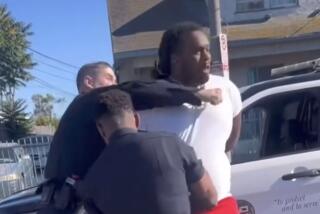How to trap a good cop
IT’S ALL but certain that the Los Angeles Police Department will be operating under a federal consent decree brought about by the Rampart scandal for at least two more years. Michael Cherkasky, who monitors the department’s progress, says the city is in compliance with only 121 of the consent decree’s 191 mandates with only six weeks remaining until the agreement is set to expire.
The most glaring failure, according to Cherkasky, is that the LAPD has not created a computer database containing “relevant information about its officers, supervisors and managers to promote professionalism and best policing practices and to identify and modify at-risk behavior (also known as an early warning system).” The database, known as TEAMS II, would be a catalog of every officer’s complete personnel history, including training, complaints, use-of-force incidents and commendations, as well as information on the officer’s traffic stops, detentions and arrests.
TEAMS II has been touted as a system that would alert LAPD managers to any sudden anomaly in an officer’s work history, such as an increase in use of force, that might portend a developing problem. But, at its best, it can do no more than spit out raw numbers on an officer’s performance on the street and compare them to his peers’. A pattern in an officer’s arrests or use of force might be evidence of something sinister, but it might just as easily not be. What to do when such a pattern is discovered is up to LAPD supervisors and managers, but many of them aren’t qualified to make that judgment.
My more than 20 years of experience in the LAPD has taught me that a relatively small number of officers do most of the work in any of the 19 police stations across the city. They make the most arrests, handle the most calls and write the most tickets. These cops are unafraid to go into the city’s most crime-ridden neighborhoods and confront the most violent criminals. And supervisors most often call on these officers to go hands-on with someone who refuses to go to jail like a gentleman. It shouldn’t be surprising that these officers are involved in more use-of-force incidents and receive more complaints than their peers.
Unfortunately, the careers of some of these cops have been derailed when their superiors, looking only at raw numbers, branded them as “risk-management issues.” There are far too many supervisors and commanding officers in the LAPD who lack the experience -- or the courage -- to look beyond the numbers in determining an officer’s true worth. Sadly, the department still places a higher value on time spent behind a desk than on the street when evaluating officers for promotions. Of the top 100 candidates on the current lieutenants’ list, nearly one-third come from Internal Affairs, and most of the remainder hold various administrative jobs in Parker Center and other stations. Incredibly, only six work as field supervisors in patrol divisions. The TEAMS II system, if and when it is fully implemented, would not make leaders of people prepared only to be managers.
If TEAMS II had been up and running before the Rampart scandal, there is no guarantee that Rafael Perez, David Mack or any of the dozen or so former officers involved in misconduct would have triggered any alarms. These were not cops who became criminals. They were criminals who became cops, and they were smart enough to have been able to fly under the radar of any computerized system aiming to detect them.
I can testify from weary experience that the subsystems of TEAMS II already in place have many, many bugs. The use-of-force system, for instance, which tracks incidents of officers using even minor force on suspects, has been particularly annoying to field supervisors, who must navigate a mind-numbing array of different screens and menus to enter the required information. Worse, the system anchors sergeants to their police station computers when they should be out on the streets. When TEAMS II is fully operational, it will consume even more time.
But even if TEAMS II works as intended, it won’t be the panacea that police reformers hope. No matter how refined the technology may be, a computer system is no substitute for leadership, and despite the many improvements in the LAPD since William J. Bratton became chief in 2002, it is leadership that the department still lacks. No consent decree or computer system will ever make up for this deficiency.
Los Angeles has spent millions of dollars and committed hundreds of officers to the cause of implementing the consent decree, but if the LAPD continues to place more importance on management than on leadership, the next scandal surely won’t be long in coming.
More to Read
Sign up for Essential California
The most important California stories and recommendations in your inbox every morning.
You may occasionally receive promotional content from the Los Angeles Times.










